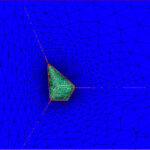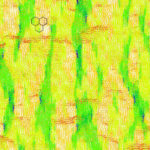Computer models allow us to test simple assumptions and follow them beyond where intuition will take us. We use computer models in conjunction with experimental and microstructural studies. Some examples are Finite Element Modeling (FEM) studies and Elastic-plastic Self-Consistent (EPSC) modeling studies.
1. Finite element modeling

Figure 1. (a) FE model mesh, inset shows an enlarged region. Properties are assigned to each of 25 grain sets (coded by color). (b-e) Equivalent von Mises stress patterns for models in compression. For (b) Young’s modulus E of grain sets ranges from 500 to 0 GPa with v=0.1 to 0.4, for (c) E= 500 to 0 GPa with v=0.3 for (d) E= 200 to 20 GPa with v=0.3 and for e) E =120 to 100 GPa with v=0.3. The maximum value of the equivalent stress in (b) is 10 times that found in (e).
2. Elastic-plastic self consistent modeling

Figure 2. EPSC simulation of the effect of plastic deformation or x-ray lattice reflections. After glide begins to opperate at 0.025%. Sample strain, lattice reflections exhibit diverging of strain due to the different degrees of plastic relaxation between the grain populations producing diffraction.

